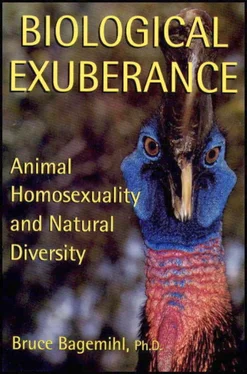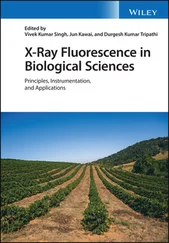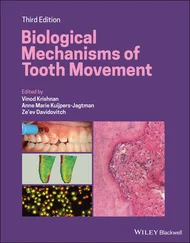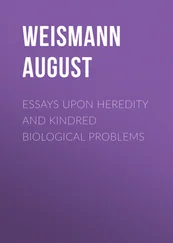BARASINGHA
IDENTIFICATION: A 3-4-foot-tall deer with a brownish coat and large antlers (3 feet long) in males. DISTRIBUTION: India, Nepal; vulnerable. HABITAT: Meadows, woodland, marshy grassland. STUDY AREA: Kanha National Park, Madhya Pradesh, India; subspecies C.d. brannderi, the South Indian Barasingha.
Social Organization
Male Wapiti/Red Deer live for nine to ten months of the year in bachelor groups, while females (cows or hinds) associate with each other and their offspring in matriarchal groups. During the rut, which lasts for one to two months, males herd females and mate polygamously with them. Barasingha generally live in groups of 3-13 animals, although toward the end of the rutting season aggregations of up to 70 Deer may form. During most of the year Barasingha herds are sex-segregated.
Description
Behavioral Expression: In both of these Deer species, homosexual mounting occurs outside of the breeding season—in females among Barasingha, and in both sexes among Wapiti and Red Deer (Wapiti or Elk is the name for this species in North America, Red Deer is the European name). In addition, Red Deer hinds sometimes mount one another when they are in heat during the breeding season. Female homosexual mounting in Wapiti generally takes place in the cow groups. Usually the two animals engaging in same-sex activity are fully grown adults, but in male Wapiti homosexual mounting may occur between adult bulls and spikehorns (yearlings whose antlers are spikes, having yet to develop prongs). Red Deer yearlings also participate in same-sex activity, including occasional incestuous homosexual mountings by females of their mothers. Homosexual mounting is done in the same position as heterosexual mating, with one animal behind the other; Red Deer stags have been observed with a full erection when mounting another male. In Wapiti and female Red Deer, same-sex (and opposite-sex) mounting may also be preceded by CHIN-RESTING, in which one animal rests its chin on the rump of the other, signaling his or her intention to mount. About a third of all Red Deer females participate in homosexual mounting as both mounter and mountee, while another third only participate as mounters, and another third only as mountees. Reciprocal mounting—in which two animals take turns mounting each other—sometimes occurs in male Wapiti. A type of same-sex, “platonic” pair-bonding is also found in this species. Both males and females may form “companionships” with an animal of the same sex; female companions are usually of the same age, while male companions may be two adult bulls, or an adult male with a younger male. Occasionally bulls will try to separate female companions during the breeding season. Their bond is strong, however, and the females travel great distances to rejoin each other, calling toward their companion until they are reunited.
A female Red Deer mounting another female
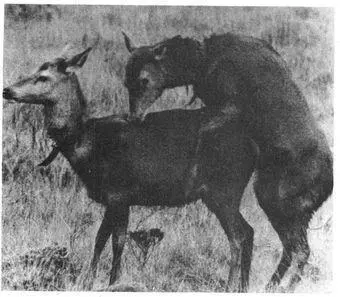
Among Red Deer, gender-mixing individuals with various antler configurations are occasionally found. In this species, the vast majority of males have antlers; however, some stags, known as HUMMELS, physically resemble females in that they do not have this secondary sexual characteristic. Interestingly, hummels are in many ways more successful than antlered stags. Many become “master stags,” that is, the highest ranking males, because they are generally in better physical condition, more resourceful, better fighters (in spite of not having antlers), and more successful at mating with females than antlered males. In addition, a few males are PERUKES, that is, their antlers are spikes and permanently covered in velvet. Such males are generally nonreproductive, having undeveloped testes. Antlered females also sometimes occur.
Frequency: Same-sex mounting occurs occasionally among Wapiti; in Barasingha, approximately 2-3 percent of sexual activity is between females. Homosexual mounting makes up about a third of all mounting behavior outside the breeding season in Red Deer, with the majority of this activity (64 percent) taking place between females.
Orientation: In Red Deer, about 70 percent of all females engage in some homosexual activity outside the rutting season; of these, about 30 percent participate exclusively in homosexuality, while the remainder are bisexual. The proportion of homosexual activity in bisexual females ranges from 6 percent to 80 percent, with the average being about 48 percent same-sex mounting per individual. Life histories of individual Wapiti and Barasingha that participate in homosexual mounts have not been compiled, so it is not known whether they also engage in heterosexual behavior.
Nonreproductive and Alternative Heterosexualities
Significant portions of the Wapiti and Red Deer population do not participate in reproduction. Only about a third of adult male Wapiti and half of adult male Red Deer mate with females each year. In fact, some Red Deer males (and a few females) are lifetime nonbreeders, never fathering offspring; others may have a postreproductive period in their old age. Moreover, about 30 percent of females, on average, are nonreproductive each season; individuals that do not breed generally have a lower mortality rate than breeders. As described above, Deer society is largely sex-segregated: males and females live mostly separate from each other except for one month out of the year (during the breeding season). Nevertheless, some heterosexual activity does take place outside of the rutting season: younger male Wapiti—often those that did not breed the previous season—may try to court and mount females, and heterosexual mounting also occurs outside the rut in Red Deer. Interestingly, some female Wapiti come into heat outside of the breeding season, but they are usually ignored by most adult males.
Even during the breeding season, heterosexual relations are sometimes strained: female Wapiti often refuse to be mounted by adult males, and they bite or kick yearling males that try to mate with them. On the other hand, a variety of nonprocreative sexual behaviors also make up the heterosexual repertoire: male Wapiti and Red Deer may lick and nuzzle the female’s genitals, while REVERSE mounts (in which the female mounts the male) make up more than a quarter of all heterosexual activity outside the breeding season in Red Deer (they also occur in Wapiti). Both Red Deer and Wapiti males also masturbate, using a fairly unusual method: antlers in these species are actually erotic zones, and males derive sexual stimulation by rubbing them against vegetation. Red Deer stags have regularly been observed developing an erection and ejaculating from this activity. Sexual behavior by calves—including adult-calf interactions—also occurs in these species. Wapiti/Red Deer calves sometimes mount adults (including their mothers, in Red Deer), while female Red Deer occasionally mount calves. More than half of all mounting by yearling Red Deer is incestuous, with the younger animal mounting its mother. Finally, Wapiti females have developed a communal parenting or “day-care” system of CALF POOLS or CRÈCHES. These nursery groups, containing up to 50 or more calves, form in late summer to early fall, with one or two females watching over the youngsters while the other mothers go off on their own.
Other Species
In Pere David’s Deer (Elaphurus davidianus) stags sometimes mount each other, with younger males typically mounting older ones. Male Reeve’s Muntjacs (Muntiacus reevesi), a small Chinese Deer, sometimes court other males. Transgendered peruke stags occasionally occur in other species such as Sika Deer (Cervus nippon )—where they may have a female coat color—Roe Deer (Capreolus capreolus), and Fallow Deer (Dama dama). In addition, intersexual individuals combining the genitals or reproductive organs of both sexes also occur in these species, as do Indian Muntjacs (Muntiacus muntjak ) with a combined male-female chromosomal pattern (XXY).
Читать дальше
